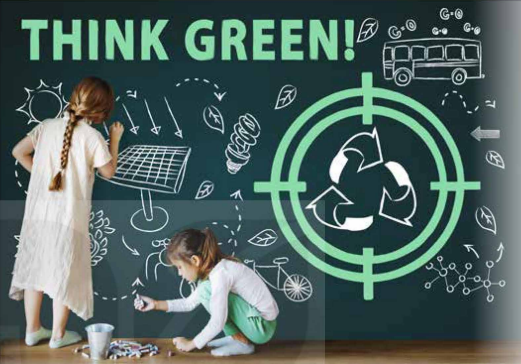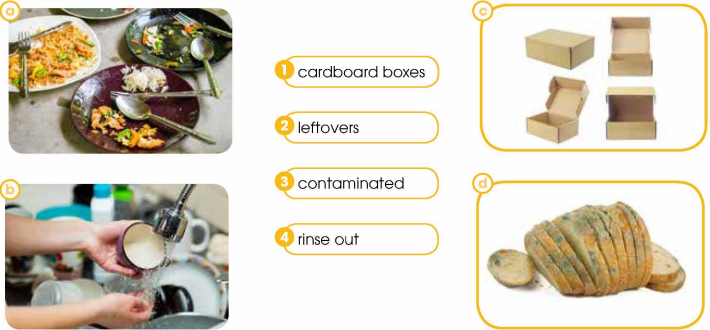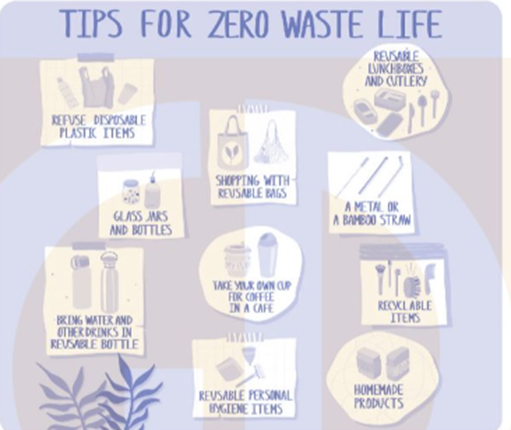Giải SGK, SBT Unit 3. Green living Global Success
Giải SGK, SBT Unit 3 Global Success
2. Read the conversation again and tick (✓) the green ideas mentioned in 1.
(Đọc lại đoạn hội thoại và đánh dấu ✓ vào những ý tưởng xanh được đề cập ở bài 1.)
|
1. putting more plants in the classroom |
|
|
2. asking students to bring single-use water bottles |
|
|
3. placing a big water jug in the classroom |
|
|
4. leaving lights and air conditioners on when leaving the classroom |
|
|
5. placing reminders on saving electricity near doors |
|
Diphthongs /ɪə/, /eə/, and /ʊə/
(Nguyên âm đôi /ɪə/, /eə/, và /ʊə/)
1. Listen and repeat. Then practise saying the words.
(Lắng nghe và lặp lại. Sau đó thực hành nói các từ.)
|
/ɪə/ |
/eə/ |
/ʊə/ |
|
idea /aɪˈdɪə/ years /jɪə(r)/ |
awareness /əˈweənəs/ air conditioners /ˈeə kəndɪʃənə(r)/ |
sure /ʃʊə(r)/ ecotour /ˈiːkəʊtʊər/ |
Green living (Sống xanh)
1. Match each word (1-5) with its meaning (a-e).
(Nối mỗi từ (1-5) với nghĩa của nó (a-e).)
|
1. waste (n) 2. landfill (n) 3. reuse (v) 4. packaging (n) 5. container (n) |
a. an area of land where waste materials are buried under the surface b. materials used to wrap or protect things we buy from shops c. something such as a box or bowl that you can use to keep things in d. to use something again e. the act of using something in a careless way, causing it to be lost or destroyed |
3. Read the email extracts again. Complete the summary notes with information from the text. Use no more than TWO words for each gap.
(Đọc lại các trích đoạn email. Hoàn thành các ghi chú tóm tắt với thông tin từ văn bản. Sử dụng không quá HAI từ cho mỗi chỗ trống.)
|
Single-use plastics can be: |
Tips |
|
reduced |
- use (1) ________ instead of plastic packaging - bring a (2) ________ water bottle reuse |
|
reused |
- reuse (3) ________ many times - reuse single-use plastic containers |
|
recycled |
- avoid plastics with (4) ________ that are hard to recycle - (5) ________ containers before recycling |
4. Read the email extracts again. Match the following information with the right names.
(Đọc lại các đoạn trích email. Nối các thông tin sau với tên thích hợp.)
|
1. This person has learnt from a past mistake how to recycle things properly. 2. This person's green lifestyle is supported by a local business. 3. This person has learnt the recycling symbols to help the recycling process. 4. This person's green habit depends on local drinking water facilities. 5. This person tries to reuse plastic takeaway containers. |
a. Hai b. Phuong c. Hoang d. Ha e. Binh |
Paper: Reduce, Reuse, and Recyle!
(Giấy: Cắt giảm, Tái sử dụng, và Tái chế!)
1. How can we save trees, energy, and water used to make paper? Sort these activities into Reduce, Reuse, or Recycle activities.
(Làm thế nào chúng ta có thể tiết kiệm cây cối, năng lượng và nước dùng để sản xuất giấy? Sắp xếp các hoạt động này thành các hoạt động Giảm thiểu, Tái sử dụng hoặc Tái chế.)
|
a. Choosing recycled paper for daily use |
______________ |
|
b. Sorting paper waste |
______________ |
|
c. Printing on both sides of the paper |
______________ |
|
d. Using old paper as compost |
______________ |
|
e. Using reusable containers rather than paper for packaging |
______________ |
|
f. Using smart devices to take notes instead of using paper |
______________ |
|
g. Using the blank side of a sheet to take notes |
______________ |
|
h. Avoiding printing things out as much as possible |
______________ |
|
i. Keeping paper waste as clean as possible |
______________ |
3. Listen again. Decide whether the statements are true (T) or false (F).
(Nghe lại. Quyết định xem các câu phát biểu là đúng (T) hay sai (F).)
|
|
T |
F |
|
1. Use dry leaves as green materials. (Sử dụng lá khô làm vật liệu xanh.) |
|
|
|
2. Use fruit peels as green materials. (Sử dụng vỏ trái cây làm nguyên liệu xanh.) |
|
|
|
3. Add additional layers in the same order. (Thêm các lớp bổ sung theo thứ tự tương tự.) |
|
|
|
4. Leave the pile dry for many days. (Để đống khô trong nhiều ngày.) |
|
|
|
5. Add chemical fertilisers. (Bón phân hóa học.) |
|
|
A problem-solving report on green solutions
(Báo cáo giải quyết vấn đề về những giải pháp xanh)
1. Work in pairs. Complete the notes using the words in the box.
(Làm việc theo cặp. Hoàn thành ghi chú bằng cách sử dụng các từ trong hộp.)
|
compost piles automatic public transport recycle |
|
Problems & consequences |
Green solutions |
|
Many single-use plastic products are thrown in rubbish bins. They take many years to decompose in landfills. |
Use them in arts and crafts projects (e.g. making plant pots) or (1) ______ them |
|
People leave the lights on and the water running in restrooms. This is a waste of electricity and water. |
Install (2) ______ lights and sensor taps that turn off when no one is around |
|
Dry leaves are sometimes burnt in the schoolyard. This can cause air pollution and fires. |
Create (3) ______ |
|
Many parents drive their children to school and pick them up from school every day. This causes traffic jams, noise, and air pollution at the school gate. |
Encourage more students to cycle or walk to school, or use (4) ______ to go to school (e.g. free bus tickets, cycle-to-school programme) |
Making predictions (Đưa ra lời dự đoán)
1. Listen and complete the conversation with the expressions in the box. Then practise it in pairs.
(Nghe và hoàn thành đoạn hội thoại với những từ ngữ trong hộp. Sau đó thực hành theo cặp.)
|
A. will have a difficult decision: sẽ có một quyết định khó khăn B. is going to impress: sẽ gây ấn tượng C. in the long run: về lâu dài D. It's hard to predict: khó để dự đoán |
Mark: Tomorrow, we'll get the results of the Green Classroom Competition. Do you think we will win?
Nam: (1) ___________ who'll win. Other classes also have very interesting projects.
Mark: I agree. The Cycling-to-school programme proposed by Class 12C (2) ___________ the judges. Cycling to school will also lead to healthier lifestyles (3) ___________.
Nam: True. There're so many great ideas. The judges (4) ___________ to make.














